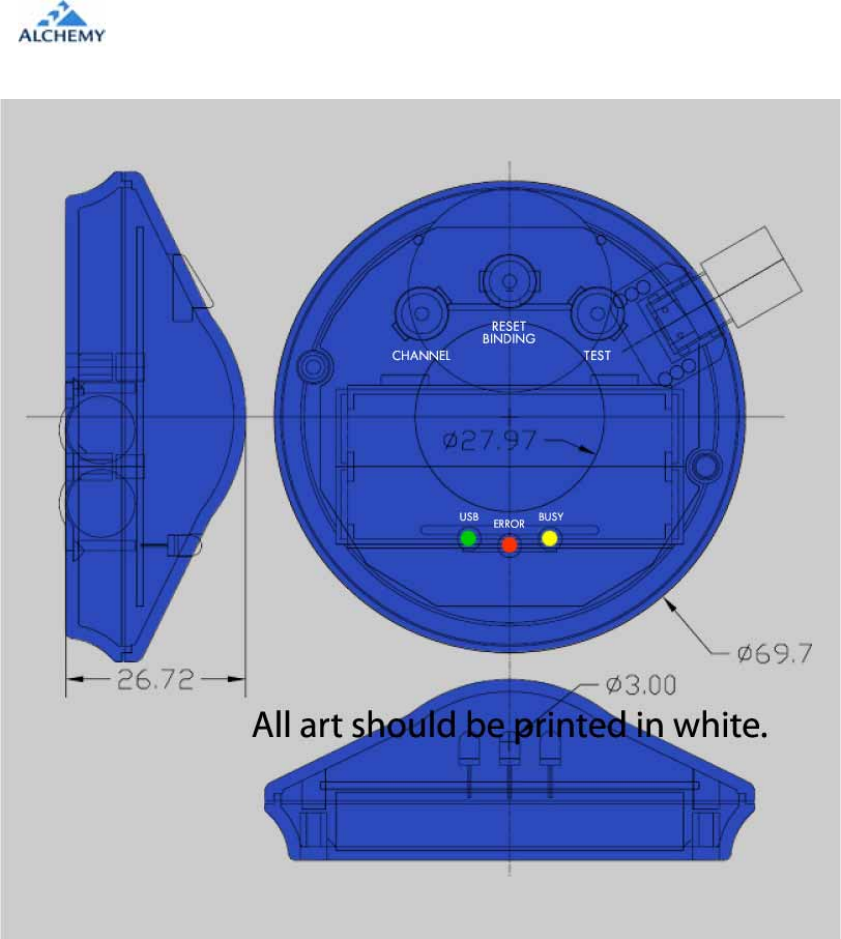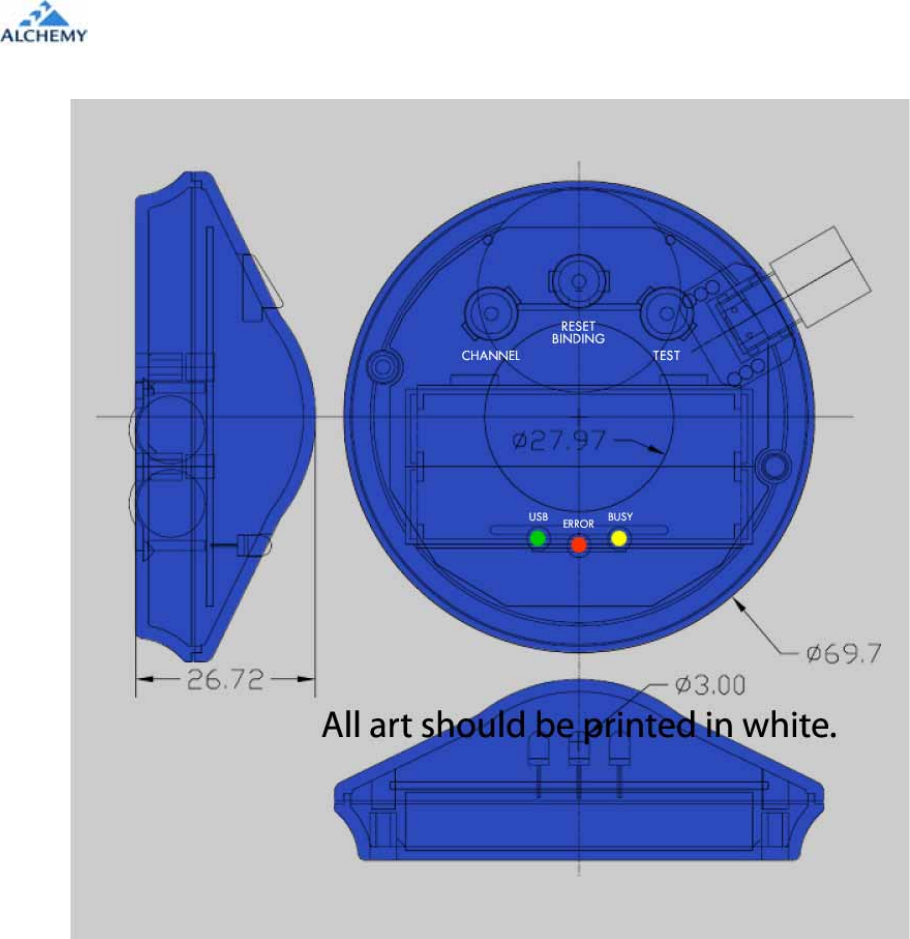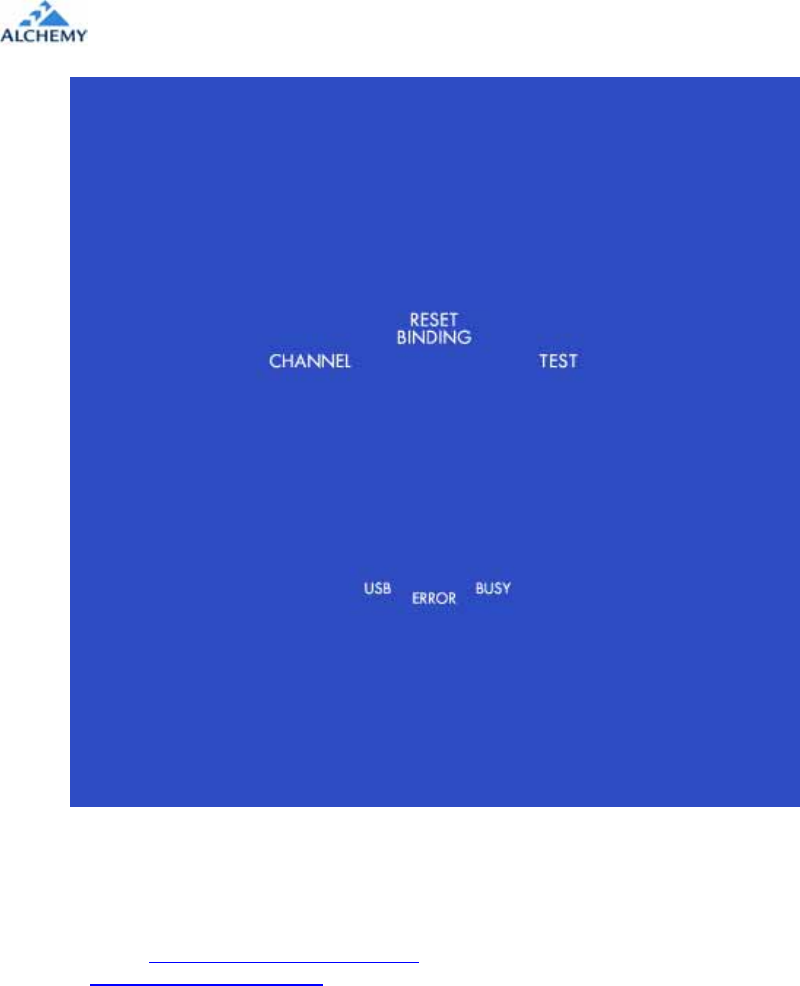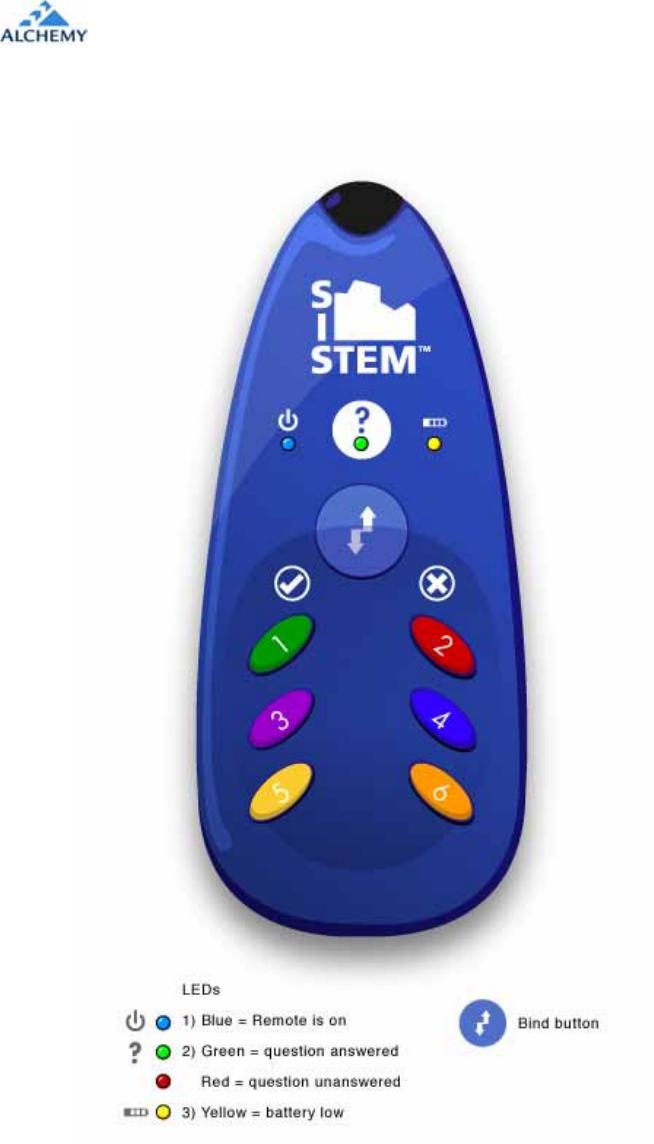Alchemy Systems LP 8015-2R Training PAD Remote System User Manual
Alchemy Systems LP Training PAD Remote System
User manual

Alchemy Systems L.P.
8015 Shoal Creek Blvd., Suite 100
Austin, TX 78757
tel: 512-637-5100
fax: 512-637-5168
www.alchemysystems.com
Alchemy Systems L.P.
SISTEM
Radio Frequency Remote Control(8015-2R) &
receiver(8015-2B)
User Guide
Version: 2.4
Prepared by: Carlos A Acosta
Date: July 7, 2008

RFI: Radio Frequency Remotes
Request for Information Alchemy Systems L.P. Page 2 of 13
Federal Communication Commission Interference Statement
This equipment has been tested and found to comply with the limits for a Class B
digital device, pursuant to Part 15 of the FCC Rules. These limits are designed to
provide reasonable protection against harmful interference in a residential
installation. This equipment generates, uses and can radiate radio frequency
energy and, if not installed and used in accordance with the instructions, may
cause harmful interference to radio communications. However, there is no
guarantee that interference will not occur in a particular installation. If this
equipment does cause harmful interference to radio or television reception, which
can be determined by turning the equipment off and on, the user is encouraged
to try to correct the interference by one of the following measures:
• Reorient or relocate the receiving antenna.
• Increase the separation between the equipment and receiver.
• Connect the equipment into an outlet on a circuit different from that to which the
receiver is con-nected.
• Consult the dealer or an experienced radio/TV technician for help.
FCC Caution: To assure continued compliance, (example - use only shielded
interface cables when connecting to computer or peripheral devices). Any
changes or modifications not expressly approved by the party responsible for
compliance could void the user’s authority to operate this equipment.This device
complies with Part 15 of the FCC Rules. Operation is subject to the following two
conditions:
(1) This device may not cause harmful interference, and
(2) this device must accept any interference received, including interference that
may cause undesired operation
IMPORTANT NOTE:
FCC RF Radiation Exposure Statement:
This equipment complies with FCC RF radiation exposure limits set forth for an
uncontrolled environment. This equipment should be installed and operated with
a minimum distance of 20 centimeters between the radiator and your body.This
transmitter must not be co-located or operating in conjunction with any other
antenna or transmitter.

RFI: Radio Frequency Remotes
Request for Information Alchemy Systems L.P. Page 3 of 13
1. Introduction
1.1. Alchemy Systems L.P.
Alchemy Systems LP, based in Austin, Texas, provides effective solutions for developing,
delivering, and tracking critical skills training to large groups of job seekers and workers
that don't typically have access to computers. Courses are delivered and managed
through our unique group-based training platform or as individual e-learning courses
through our enterprise-ready learning management system. Alchemy's course catalog
includes highly-interactive educational media and covers topics such as job search,
career readiness, industrial safety, mandated training, basic supervision and job success
skills as well as industry specific training courses.
1.2. Detail
Alchemy is interested in the potential of RF remote controllers for use with the SISTEM™
product. It is perceived that a change to RF remote controllers will enable SISTEM™ to
meet the growing needs of our clients.
The list of high-level requirements and nice-to-have requirements that Alchemy has
determined would be beneficial for the SISTEM™ product are specified in the SISTEM:
Integration of Radio Frequency (RF) Remotes Business Requirements document.
The purpose of this document is to extend the Business Requirements document into
technical specifications that will be use for the design and development of RF Remote
Controls (Clickers) solution.

RFI: Radio Frequency Remotes
Request for Information Alchemy Systems L.P. Page 4 of 13
2. Technical Specifications
SISTEM Controller Software
2.1.1. SISTEM software shall be able to link a Clicker’s unique identifier with a
participant record.
2.1.2. SISTEM software; during questions answering mode; shall be able to display a
list participants at the bottom of the screen for those participants that have not
answered the question. This participant’s exception list will show up at the
bottom of the screen after a configured percentage of the participants have
casted there vote (answer). The percentage will be specified in a configuration
file and shall be defaulted to 50%. This value will be able to be changed through
the SISTEM administration interface.
2.1.3. SISTEM shall support a Course Management Bar (CMB) that is found at the
bottom of the screen during a course. It includes several buttons for managing
the participants and the course. The bar also includes visual indicators for
representing the status of student responses as well as the course. See detail
requirements for CMB at the Functional Specifications document date October 3,
2007 here:
( \\Scfs01\Departments\Department Public Shares\Instructional Design
Public\Projects\RF Clickers\ SISTEM_RF_FS.doc ) Section 2.1.2
2.1.4. SISTEM Course Management Bar shall be used to display a list of participants
that have not voted or are having problems related to remote to base station
communication issues.
2.1.5. SISTEM CMB shall provide access to the Participant Management window. The
purpose of the Participant Management Window is to provide roster and student
management functions to course administrators during a course. The
Participant Management Window includes the features specified for Option A on
the functional requirements document date October 3, 2007 here:
(http://www.redminealchemy.com/redmine/documents/show/17) section 2.2 :
2.1.6. SISTEM software shall support two different methods of assigning clickers to
students. The selected registration method will be specified in the registration UI
screen by using a checkbox called “Self Registration”. The default value of this
checkbox will be stored in a configuration file and will be selected in the
SISTEM administration panel.
Method one provides for assigning one clicker to one student at a
time like it is done today.
Method two will support multiple participants registering/binding
their remote to their participant record simultaneously.
Use Case:
Method two will expedite the participants’ registration
process to support up to 150 participants. Method two will list
up to 16 student’s names at the same time.
Each student will have a unique clicker identification
number beside their name. The clicker identification number

RFI: Radio Frequency Remotes
Request for Information Alchemy Systems L.P. Page 5 of 13
will consist of four digits. Each digit of the number shall be 1-6
inclusive.
Each student will need to key in their number on the
remote and SISTEM must capture the 4 key sequence for
each remote to construct the pin number and match the
number with a student record.
2.1.7. SISTEM software shall support multiple participants registering/binding their
remote to their participant record simultaneously. This will expedited the
participants’ registration process to support up to 150 participants.
2.1.8. SISTEM shall support the ability to create class roster lists. This list will reduce
the people list to just the people that are scheduled for training instead of the
entire employee list. This is needed to support multiple participants’ registration
functionality.
2.1.9. The roster list shall be managed (create new student, select student, add and
remove student)by SISTEM operator.
2.1.10. The roster list shall be stored locally on the targeted SISTEM computer.
2.1.11. The roster list shall be managed remotely via web browser. This will enable
an instructor to prepare for the training session without having to leave his
primary work area. Note: This requirement is deferred and will not be
implemented as part of this project.
2.1.12. SISTEM software shall provide a web enabled interface exposes SISTEM
administration features. This will enable the instructor to manage their work
using the LMS as an alternate user interface and linking to SISTEM via a web
browser to manage:
Database synchronization
Upload training records.
Web services
Change passwords
Manage class rosters and student registration.
Note: This requirement is deferred and will not be implemented as part of this project.
2.1.13. SISTEM shall be able to detect when the base station cannot communicate
with a clicker that has been registered to a participant.
2.1.14. SISTEM shall allow a SISTEM operator to add and remove remotes that will be
configured and linked to a specific SISTEM computer.

RFI: Radio Frequency Remotes
Request for Information Alchemy Systems L.P. Page 6 of 13
SISTEM RF Base Station
2.1.15. Base Station shall communicate with remote controls on 2.4 GHz frequency.
2.1.16. Base Station shall be able to communicate with remotes within a range of 150
ft.
2.1.17. Base Station shall communicate with up to 150 remote controls concurrently.
2.1.18. Base Station shall communicate with computer interface via USB 2.0.
2.1.19. Base Station shall communicate with computer as a USB to Serial interface.
Ex. FTDI driver).
2.1.20. Base Station shall be powered via host computers USB interface.
2.1.21. Base Station shall support Application Programming Interface (API) to send
and receive messages from the base station.
2.1.22. API function to read remote control messages from base station.
2.1.23. API function to start base station transceiver to poll/receive messages from
remotes.
2.1.24. API function to stop base station transceiver from polling/receiving messages
from remote.
2.1.25. API function to change Base Unit Channel/Frequency. This will support the
scenario when communication interference occurs, and the SISTEM operator has
to switch to a clear channel.
2.1.26. API function to read a specified remote control battery status.
2.1.27. API function to read a specified remote control “online” status. Meaning that
the Base Station can communicate with a specified remote.
2.1.28. Base Station shall support 2 antennas. The use of 2 antennas at the base
station will improve signal quality by implementing antenna diversity. Antenna
diversity is a transmission technique in which the information-carrying signal is
transmitted along different propagation paths. This can be achieved by using
multiple receiver antennas (diversity reception) and/or by using multiple
transmitting antennas (transmit diversity).
2.1.29. Base Station plastic case shall follow the following specifications per following
drawings:

RFI: Radio Frequency Remotes
Request for Information Alchemy Systems L.P. Page 7 of 13
eLearning 2.4 GHz Transceiver (Two-way) Base Station Design control function (EX)
LED Display state Part
LED 1: USB connection Indication Display
LED 2: On Line Display or Error
LED 3: Busy communication
SW 1: Channel (frequency) control (clear channel) Knob
SW 2: Reset (binding) Knob
SW 3 : Testing or Buard rate control Knob

RFI: Radio Frequency Remotes
Request for Information Alchemy Systems L.P. Page 8 of 13
Bottom cover serial no sticker Label
Mechanical Drawing Unit : m/m

RFI: Radio Frequency Remotes
Request for Information Alchemy Systems L.P. Page 9 of 13
2.1.30. The Base Station shall display a label at the bottom cover with the following
information:
Alchemy Systems, LP
toll free: 1(888) 988-8832
Email: support@alchemysystems.com
www.alchemysystems.com
2.1.31. Base Station shall be able to signal the clickers to turn their power off.

RFI: Radio Frequency Remotes
Request for Information Alchemy Systems L.P. Page 10 of 13
SITEM RF Remote Controls/Clickers
2.1.32. Clickers shall communicate with remote controls on 2.4 GHz frequency.
2.1.33. Clickers shall be able to communicate with base station remotes within a range
of 75 ft.
2.1.34. Clicker shall support the ability bind to a specific base station.
2.1.35. Clicker shall provide participant feedback by using green led to indicate that
message was received by the Base Station.
2.1.36. Clicker shall provide participant feedback by using an Answer LED.
2.1.37. The answer LED light will remain Off while there is no questions to be
answered, meaning the base station is not receiving answers
2.1.38. The answer LED light will turn on solid red, when the base station is enabled
to start receiving answers.
2.1.39. The answer LED light will remain On but change color to Green when answer is
received by the base station.
2.1.40. The answer LED light will flash red if remote fails to send an answer to the
base station.
2.1.41. During the remote-base station Simple MAC binding process:
The answer LED light shall turned green after a remote
successfully binds to its base station.
If the remote is unable to bind then the answer LED light will flash
red. This should only happen if a remote is having difficulties
communicating with the base station. For example the base
station power is off.
2.1.42. The power LED will be Off when Remote is not in used.
2.1.43. The power LED will be On solid blue when Remote is powered up.
2.1.44. The Battery level indicator shall be implemented by using an LED battery level
indicator..
2.1.45. Clicker shall not have a dedicated power switch.
2.1.46. Clicker shall be able to power on by pressing any of the 7 keys on the keypad.
2.1.47. Clicker shall power off by pressing down and holding any key for 10 sec.
2.1.48. Clicker shall power off after 60 minutes of inactivity.
2.1.49. Clicker shall support 6 buttons that will be used for multiple choices answers.
2.1.50. Clicker shall support a 7th button to be used for remote binding purposes. This
key will display a (ÅÆ) symbol on it.

RFI: Radio Frequency Remotes
Request for Information Alchemy Systems L.P. Page 11 of 13
2.1.51.
2.1.52. Clickers buttons shall be color coded as:
Green - 1
Red – 2
Purple – 3
Blue – 4
Yellow – 5
Orange – 6
Teal – (ÅÆ)
NOTE: use same colors as the current IR remote controls.
2.1.53. Clickers’ buttons shall be labeled:
Number 1 on the button with “/” and a check mark √. ( 1 / √) .
Number 2 on the button with “/” and an X. ( 2 / X)
Number 3 on the button.
Number 4 on the button
Number 5 on the button
Number 6 on the button
Symbol “ÅÆ” on binding button.
2.1.54. Clickers buttons positions should be equally distributed on the key pad area in
the following order:
( 1/√ ) ---- ( 2/X )
( 3 ) ---- ( 4 )
( 5 ) ---- ( 6 )
(ÅÆ)

RFI: Radio Frequency Remotes
Request for Information Alchemy Systems L.P. Page 12 of 13
This picture is provided to describe the buttons layout concept and should not be used as
the final remote casing design.
2.1.55. Clickers shall support the ability to support 1 key press answers. Meaning that
when a participant pres any one button out of the 6 answers buttons, the clicker
will transmit the keypad code to the base station without the need of pressing a
“send” button.
2.1.56. The Clicker shall display a label at the bottom cover with the following
information:

RFI: Radio Frequency Remotes
Request for Information Alchemy Systems L.P. Page 13 of 13
Alchemy Systems, LP
toll free: 1(888) 988-8832
Email: support@alchemysystems.com
www.alchemysystems.com